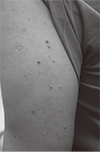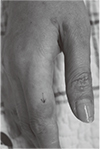Abstract
Diabetes mellitus (DM) is a metabolic disease characterized by relative or absolute insulin deficiency. The hyperglycemic state of DM leads to changes in practically every cell type and organ of the human body. As skin changes can manifest before onset of DM, they might have diagnostic relevance. Some skin disorders are highly associated with increased risk of important outcomes, such as skin lesions, ulcerations, and diabetic foot, which can be associated with significantly increased morbidity and mortality of DM patients. Disease control, early-stage treatment (e.g., skin hydration, orthotic devices), and awareness of skin disorders can reduce morbidity of DM patients. Thus, better understanding of the burden of skin disorders in DM patients can help to improve the quality of life of them. The purpose of this study is to review the literature to evaluate the main clinical characteristics and complications of skin disorders in diabetic patients.
Figures and Tables
References
1. Shaw JE, Sicree RA, Zimmet PZ. Global estimates of the prevalence of diabetes for 2010 and 2030. Diabetes Res Clin Pract. 2010; 87:4–14.

2. Lee SJ, Cha YC, Lee WC, Na GY, Kim DW, Ha SW, Kim BW. The management of diabetic foot ulcer by corporation of dermatologists and internists. Korean J Dermatol. 2002; 40:1316–1324.
3. Mahajan S, Koranne RV, Sharma SK. Cutaneous manifestation of diabetes mellitus. Indian J Dermatol Venereol Leprol. 2003; 69:105–108.
4. Yosipovitch G, Hodak E, Vardi P, Shraga I, Karp M, Sprecher E, David M. The prevalence of cutaneous manifestations in IDDM patients and their association with diabetes risk factors and microvascular complications. Diabetes Care. 1998; 21:506–509.

5. Rubin Grandis J, Branstetter BF 4th, Yu VL. The changing face of malignant (necrotising) external otitis: clinical, radiological, and anatomic correlations. Lancet Infect Dis. 2004; 4:34–39.

7. Lugo-Somolinos A, Sánchez JL. Prevalence of dermatophytosis in patients with diabetes. J Am Acad Dermatol. 1992; 26:408–410.

9. Kiziltan ME, Benbir G. Clinical and nerve conduction studies in female patients with diabetic dermopathy. Acta Diabetol. 2008; 45:97–105.

10. Morgan AJ, Schwartz RA. Diabetic dermopathy: a subtle sign with grave implications. J Am Acad Dermatol. 2008; 58:447–451.

11. Bhargava P, Mathur SK, Mathur DK, Malpani S, Goel S, Agarwal US, Bhargava RK. Acrochordon, diabetes and associations. Indian J Dermatol Venereol Leprol. 1996; 62:226–228.
12. Sudy E, Urbina F, Maliqueo M, Sir T. Screening of glucose/insulin metabolic alterations in men with multiple skin tags on the neck. J Dtsch Dermatol Ges. 2008; 6:852–856.

14. Verrando P, Ortonne JP. Insulin binding properties of normal and transformed human epidermal cultured keratinocytes. J Invest Dermatol. 1985; 85:328–332.

15. Maitra SK, Rowland Payne CM. The obesity syndrome and acanthosis nigricans. Acanthosis nigricans is a common cosmetic problem providing epidemiological clues to the obesity syndrome, the insulin-resistance syndrome, the thrifty metabolism, dyslipidaemia, hypertension and diabetes mellitus type II. J Cosmet Dermatol. 2004; 3:202–210.

16. Yamaoka H, Sasaki H, Yamasaki H, Ogawa K, Ohta T, Furuta H, Nishi M, Nanjo K. Truncal pruritus of unknown origin may be a symptom of diabetic polyneuropathy. Diabetes Care. 2010; 33:150–155.

17. Yamaoka H, Sasaki H, Yamasaki H, Ogawa K, Ohta T, Furuta H, Nishi M, Nanjo K. Truncal pruritus of unknown origin may be a symptom of diabetic polyneuropathy. Diabetes Care. 2010; 33:150–155.

19. Haim S, Friedman-Birnbaum R, Shafrir A. Generalized granuloma annulare: relationship to diabetes mellitus as revealed in 8 cases. Br J Dermatol. 1970; 83:302–305.

20. El Fekih N, Zéglaoui F, Sioud A, Fazaa B, Kharfi M, Gaigi S, Kamoun R. Bullosis diabeticorum: report of ten cases. Tunis Med. 2009; 87:747–749.




 PDF
PDF ePub
ePub Citation
Citation Print
Print








 XML Download
XML Download